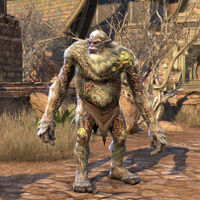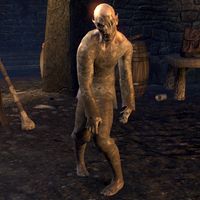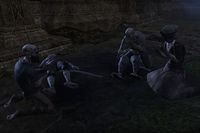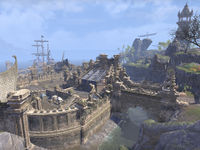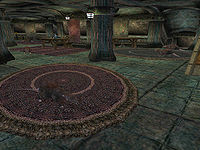Lore:Knahaten Flu
| To meet our site's higher standard of quality, this article or section may require cleanup. The user who placed this here had the following concern: Needs info from Into the Temple quest To leave a message about the cleanup for this article, please add it to this article's talk page. |
The Knahaten Flu (also known as the Knahaten Plague[1] or the Crimson Plague)[2][UOL 1] was one of the deadliest diseases to infect the populace of Tamriel, lasting for 43 years, from the year 2E 560[3][4][5] to 2E 603.[6] The dangerous disease, once widespread across Tamriel, was thought to have been stamped out during the Second Era.[2]
Contents
History[edit]
Origins[edit]
There are two theories about how the Knahaten Flu was introduced to Tamriel. One account speaks of an Argonian shaman[4] who, in retaliation for the awful treatment of his people by the other races, created the disease "through a manipulation of their cherished spore-trees"[3] – the Hist. Another account attributes the disease to natural causes.[4] Since Argonians were immune to the Flu,[3][4] the former story was popularly accepted.[7] However, an Ayleid spirit implies that the flu was instead created by the Ayleids as a weapon against the Kothringi, and was chagrined that it had left Kothringi survivors.[8]
The Knahaten Flu began in the city of Stormhold in 2E 560, and quickly spread to every corner of Black Marsh and beyond, killing all infected non-Argonians. It continued to plague Tamriel for over four decades, the last known cases of the Flu being documented in the year 2E 603.[6]
Aftermath[edit]
There is no definitive death toll of the disease. However, the Flu almost completely destroyed the non-Argonian population of Black Marsh, and instilled outsiders with a fear of the province for centuries. Only Dunmer slavers of House Dres, with their entire economy dependent on the slave workforce, remained there. It was said that even Tiber Septim himself thought twice before invading Black Marsh.[4][9] Fear of the disease persisted late into the Third Era, when a mass panic was caused by an alleged relapse of the Flu.[1]
Regardless of the Flu's source, the situation in Black Marsh became increasingly favorable to the Argonians after the disease struck. After the assassination of Potentate Savirien-Chorak and the dissolution of the Second Empire, Cyrodiil lost its grip over most of the province.[10] Once the Flu struck, the Empire lost any hope of controlling Black Marsh.
The Knahaten Flu was, indirectly, one of the main causes of the Three Banners War. By destroying the royal family of Wayrest, it brought King Emeric to the throne from which he forged the Daggerfall Covenant.[11] It was a crisis in Elsweyr, motivating the Khajiit to join the Aldmeri Dominion out of respect and gratitude for the many elves who had rendered aid during the worst years of the Flu.[12][13] And of course, it provided the Argonians with enough independence to join the Ebonheart Pact as equals to the Dunmer, rather than as slaves.
The Flu also motivated changes to enforce higher standards in food quality and safety; for instance, it made the Summerset Navy rethink their regulations concerning rations.[14]
Symptoms, Treatment and Transmission[edit]
Early symptoms of the Flu include "general malaise, loss of appetite, and fatigue," followed shortly by weakness, headaches,[15] aching muscles, sharp pain in the shoulders, chills, and watering eyes. Late-stage symptoms include wracking cough, high fever, and blood flowing out of the nose, eyes and eventually the mouth. The most prominent sign of the disease was a red, granular rash, which did not itch but spread all over the body.[16] Infection can result in muteness.[2] Death usually occurred within three painful days of infection, but some victims were able to survive for up to a week.[17]
While the worst of the symptoms could be alleviated by sorghum-tea[12] and chicken broth,[18] the search for a cure was impeded by many questionable alleged treatments. For instance, a Redguard named Perizada supposedly saved an entire village with a potion made by boiling clannfear claws in salt water, but she later succumbed to the plague herself.[16]
The common disease tends to spread easily and acts quickly.[2] How the disease spread is not definitively known.[16] One source claims it was airborne,[5] while another claims that it was spread through physical contact with the victim's particular rash. The latter theory is supported by reports that infected people who covered their rashes with clothing and bandages were less contagious.[16] Though they were immune to the Knahaten Flu themselves, Argonians were often suspected to be carriers of the disease, perhaps due to the common belief that they had created it.[7]
Victims[edit]
At its height, the Knahaten Flu engulfed most of Tamriel. It spread from Black Marsh, where it started, to southern Morrowind[4] and across the Topal Bay to Elsweyr,[5] and from there to Valenwood[19] and even High Rock.[11]
The Flu managed to destroy cities, religions, and even entire cultures. The high and mighty were not exempt, as it consumed the entire royal family of Wayrest,[11] ending the Gardner Dynasty,[20] as well as the hero Oreyn Bearclaw, who performed many good deeds in Valenwood before succumbing to the disease.[21] Also in Valenwood, the Flu nearly wiped out worshipers of Z'en, leading to the Bosmer abandoning his worship entirely soon afterward.[19]
The entirety of Elsweyr suffered greatly from the Flu, though the city of Senchal suffered the most. A strain of the disease crossed the channel in 2E 560 and infected most of the populace. Soon there was damage to the city itself, as paranoia raged rampant, and entire sections of the city were burned to slow down the Flu, never to be rebuilt again. An account from three hundred years later said that visitors to Senchal could still see the "charred skylines on the periphery, as black and jagged as the teeth of the nearest sugar junkie, begging for cake."[5] The disease in Elsweyr was alleviated only with the help of the Altmer, who saved many lives, indebting the Khajiit to them.[13] Despite heavy loss of life, the Mane's Legion managed to reimpose order and implement medical discoveries made by various Clan-Mothers.[12]
In 2E 563 the Knahaten Flu reached the Systres, slaying commoner and noble alike. Duke Avrippe Mornard ordered the archipelago sealed off in 2E 565, causing trade to stagnate, which caused Duke Avrippe to fall into disfavor in Wayrest's court.
The Stricken[edit]
The Stricken were Khajiit whose bodies were ravaged by the Knahaten Flu but ultimately survived their infection with the disease. The Stricken were cast out of Khajiiti society due to rampant fear and hatred of those infected with the Flu. When the outbreak began, Khajiit flocked to S'rendarr's Cradle in small numbers. The adepts tried their best to heal everyone, but many died. Rumors spread that healing could be found within S'rendarr's Cradle, and those afflicted by the Flu came by the dozens. King Hemakar viewed the large numbers of sick people in such close quarters as a breeding ground for the disease. Despite these fears, the adepts of S'rendarr's Cradle tried their best to accommodate everyone and keep the adeptorium sanitary.[22] Many orphaned children were taken in by the adepts during this time.[23]
All was going as well as it could until Sutabi, vizier to King Hemakar, arrived at S'rendarr's Cradle with a host of war-cats. Sutabi threatened to raze the adeptorium in order to contain the infection. If S'rendarr's Cradle continued to harbor Flu victims, the adeptorium would burn. Thus, the sick were led to nearby Baan Dar's Litter by the adepts and left to die. Those who survived their affliction became known as the Stricken, and they lived in the canyon east of S'rendarr's Cradle for over eighteen years.[22]
While it was known that those who had survived the flu could no longer transmit it, many residents remained indifferent. Several Khajiit survivors were reported to still reside in Rimmen following their recovery from the flu.[24]
The Kothringi and the Crimson Ship[edit]
Those most affected by the Knahaten Flu were the human population of Black Marsh. Most notable among them were the native silver-skinned Kothringi, whose settlements of Stillrise Village and Zuuk were already lifeless by 2E 561.[25][26] The Kothringi are thought to have been completely exterminated by it.[3][4][nb 1]
One of the most famous stories from those troubled times is that of the Crimson Ship. Filled with Kothringi refugees, it left the shores of Black Marsh on the 9th of First Seed, 2E 563, only to be turned back at every port. After a year on the sea, they reached Hammerfell, and with no one to shelter them, they sailed west[6] to the Abecean Sea. The book, Pirates of the Abecean tells a tale of the discovery of the ship, found adrift by a group of pirates, its entire crew dead.[27] The tale appears to be fictional, as no official records exist that confirm the discovery of the ship. In 2E 582, a Khajiit beggar claimed to have been on a ship that encountered the vessel during his service in the Imperial army, blaming the event for his misfortunes. However, the reliability of his testimony is questionable.[28]
To memorialize this event, the people of Hammerfell honor the 20th of Rain's Hand as the Day of Shame. Nobody leaves their house, for it is told that the Crimson Ship will return on this day.[29]
Attempted Resurgence[edit]
In 3E 427, the tomb of Gedna Relvel in the ruins of Old Mournhold was unsealed. Relvel, once a powerful sorceress condemned for studying and practicing forbidden magics, had cheated death and become a lich. She then attempted to spread the Crimson Plague throughout the city of Mournhold by infecting rats with the disease. The lich was destroyed by the Nerevarine before the disease could spread to more than a few people.[2]
Notes[edit]
See Also[edit]
Articles[edit]
- Thrassian Plague — An article concerning a disease of even more massive proportions.
- Diseases — An article detailing other, more common diseases of Tamriel.
Books[edit]
- On the Knahaten Flu by Archivist Neleminduure — A description of the Knahaten Flu
- The Eagle and the Cat by Lord Gharesh-ri, Speaker for the Mane — A description of the outbreak of the Knahaten Flu
- The Ruby Necklace — A warning goes unheeded
- Pirates of the Abecean — A tale of a pirate crew's encounter with the infamous Crimson Ship
- Journal of Thracius Mento by Thracius Mento — A priest of the Divines' account of the Knahaten Flu
- First Signs of the Flu — An Orcrest citizen's thoughts on the Knahaten Flu
- Flu Victim's Note — A Knahaten Flu afflicted's final thoughts
References[edit]
- ^ a b Pocket Guide to the Empire, 3rd Edition: The Seat of Sundered Kings: Cyrodiil — Imperial Geographical Society, 3E 432
- ^ a b c d e Crimson Plague quest in Morrowind: Tribunal
- ^ a b c d Pocket Guide to the Empire, 1st Edition: The Wild Regions — Imperial Geographical Society, 2E 864
- ^ a b c d e f g Pocket Guide to the Empire, 3rd Edition: The War with the Trees: Argonia and the Black Marsh — Imperial Geographical Society, 3E 432
- ^ a b c d Pocket Guide to the Empire, 1st Edition: The Elsweyr Confederacy — Imperial Geographical Society, 2E 864
- ^ a b c The Daggerfall Chronicles — Ronald Wartow
- ^ a b Argonians Among Us — Sil Rothril
- ^ Morilye's dialogue during Into the Temple in ESO
- ^ Dreekius in Redguard
- ^ Pocket Guide to the Empire, 3rd Edition: All the Eras of Man, A Comprehensive History of our History — Imperial Geographical Society, 3E 432
- ^ a b c Triumphs of a Monarch — His Majesty King Emeric
- ^ a b c The Eagle and the Cat — Lord Gharesh-ri, Speaker for the Mane
- ^ a b Introduction to the Lore of The Elder Scrolls Online
- ^ The Epic of the Grey Falcon — Anido Jhone, editor
- ^ Crimson Plague disease in Morrowind: Tribunal
- ^ a b c d On the Knahaten Flu — Archivist Neleminduure
- ^ The Ruby Necklace
- ^ Journal of Thracius Mento — Thracius Mento
- ^ a b Varieties of Faith... — Brother Mikhael Karkuxor of the Imperial College
- ^ Guide to the Daggerfall Covenant
- ^ Tamrielic Lore — Yagrum Bagarn
- ^ a b Silhu-jo's dialogue during In Sickness and In Health in ESO: Elsweyr
- ^ Vazbi's dialogue during In Sickness and In Health in ESO: Elsweyr
- ^ Bindabi's dialogue in ESO: Elsweyr
- ^ Knahaten Flu Confirmed — Shaman Chirah
- ^ Drillk's Journal — Drillk
- ^ Pirates of the Abecean
- ^ Kuralit's dialogue in ESO
- ^ Holidays in Daggerfall
Note: The following references are considered to be unofficial sources. They are included to round off this article and may not be authoritative or conclusive.

